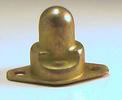
Nutplates offer a convenient anchoring solution for bolts. Also known as anchor nuts and plate nuts, they consist of a flat base — typically made of stamped sheet metal — that’s connected to a threaded tube. The threaded tube supports a threaded fastener, such as a bolt. After installing a nutplate, you can twist a threaded fastener into the tube. But there are several styles of nutplates, each of which features a different design.
#1) Fixed
Fixed nutplates feature a stationary threaded tube. Once installed, neither the threaded tube nor the fastener with which it’s used will move. Fixed nutplates remain one of the most popular styles. They are simple, reliable and easy to use.
#2) Floating
Floating nutplates offer greater positioning tolerances than their fixed counterparts. They still consist of a flat base and a threaded tube. Unlike fixed nutplates, however, floating nutplates are designed to move slightly. The threaded tube in a floating nutplate can move around. Therefore, even if the threaded fastener isn’t perfectly aligned with the floating nutplate, it may still fit. You can move and adjust the threaded tube so that the fastener reaches it.
#3) Locking
Another common style of nutplates is locking. Locking nutplates are designed to lock the threaded fastener with which they are used in place. Also known as locknuts, some of them feature deformed internal threading. As you twist a fastener into a locking nutplate, it will adhere to the deformed internal threading. Other locking nutplates use a nylon insert. Regardless, they are all designed to lock the threaded fastener in place.
#4) Two Lug
Most nutplates fall under the category of two lug. As the name suggests, they use two lugs for installation. The threaded tube is typically in the center. On each side of the threaded tube is a lug hole. You can install a two-lug nutplate by driving a pair of lugs through these holes.
#5) Capped
When shopping for nutplates, you may come across capped nutplates. Capped nutplates are distinguished from all other styles by the presence of a capped threaded tube. Other styles of nutplates have an open threaded tube. Capped nutplates, on the other hand, have a closed or capped nutplate. With a capped nutplate, you don’t have to worry about accidentally driving the fastener too deep during installation. The capped threaded tube will limit the depth at which you can install the fastener.
- SEO Powered Content & PR Distribution. Get Amplified Today.
- PlatoData.Network Vertical Generative Ai. Empower Yourself. Access Here.
- PlatoAiStream. Web3 Intelligence. Knowledge Amplified. Access Here.
- PlatoESG. Carbon, CleanTech, Energy, Environment, Solar, Waste Management. Access Here.
- PlatoHealth. Biotech and Clinical Trials Intelligence. Access Here.
- Source: https://monroeaerospace.com/blog/5-common-styles-of-nutplates/



